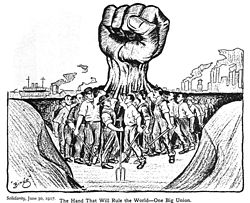
By Pete M Reclus
On October 6th, Piper, the Corresponding Secretary for WSA, gave an interactive workshop on Anarcho-Syndicalist theory, presented on her youtube channel, with live chat for discussion. She had been approached by the Anarcho-Syndicalist Collective for Education and Diffusion, based in Quebec; they had read an account in Ideas and Action about Piper’s previous workshop on the same subject for WSA members, and requested she give a similar workshop for a wider audience.
As a participant, I enjoyed this workshop a great deal. Similar to her first one, she led us through a broad swath of revolutionary history, the origins of revolutionary syndicalism in the first International, and how Anarcho-Syndicalism took more concrete form in the 1920s. She described how the Soviet dominated Third International (the Comintern) tried to control the international workers movement. but in reaction against this, in 1922 revolutionary workers revived the spirit of the First International,, what would later become the International Workers Association, AIT/IWA.
Relevant to this point, she examined how the Bolshevik strategy of setting up authoritarian states went horrifically wrong, and after a long history of calamity, led to the dissolution of the Soviet Bloc. She explained:
“This giant crisis of the capitalist world economy and its state structures gave a new life to anarcho-syndicalist theory. It gave new support to the idea that there should be a libertarian workers movement based on control by the rank and file, that organizes against state power instead of trying to take it.”
In her presentation on the Spanish revolution of 1936 to 1939, where Anarcho-Syndicalism was put into broad practice, she gave a refreshingly honest look at both successes and missed opportunities. For me as a participant, this was crucial. Our movement is based on practice and what can be learned from our mistakes, not based on distortions of history.
Another enjoyable part of her workshop was that it included participants who were very new to the basics of Anarcho-Syndicalism. While some expressed agreement and support, there were also participants from other very different political movements, such as post-Left (Postmodern) and Trotskyism, and their efforts to start some small arguments added to the evening. One of the funniest moments was when a participant, so much in keeping with this period of Covid19 online meetings, made a simple typo in his efforts to argue asking if there was such a thing as ‘Monarchist’ Syndicalism and Piper said, “I sure hope not !” The participant realized he or autocorrect had made a typo, and said, “Oh no, not ‘MONarchist’ Syndicalism, I meant MINarchist Syndicalism!”
When I take part in workshops, I’m always looking for ‘elevator explanations’ of anarchism. That is, if you had to explain what anarchism is to someone in a short elevator ride, what would you say? So, at the start of Piper’s introduction where she was defining her terms, I wrote down her definitions. I end with her definitions of Anarchism, Socialism and Anarcho-Syndicalism.
“To understand the theory of Anarcho-Syndicalism, one needs to understand Anarchism. Anarchism is a section of the socialist movement that sees the socialist society as only coming about through the destruction of hierarchical social structures. So that’s Anarchism…
“The reason we have to understand Anarchism in order to understand Anarcho-Syndicalism, is that Anarcho-Syndicalism is a strategy that was developed by anarchists in order to carry out the class-struggle, that is, to transform society.
“Anarcho-Syndicalism is a strategy based or synthesized by anarchists. While there was syndicalism apart from Anarchism , there were even forms of Marxist syndicalism, but anarcho-syndicalism was created as a strategy for the class struggle against capitalism and for socialism.
“I’ll also give a summary definition of Socialism:…Socialism is the envisioned alternative to capitalist society. It’s a post-capitalist society that has been theorized by different thinkers and moments, and such a society would be one organized through the free association of people doing labor; that free association would facilitate production for social use instead of, as under capitalist wage labor, you produce commodities to create profits.
“Anarcho-Syndicalism is a strategy for achieving socialism, and that strategy is the organization of labor unions to carry out class struggle. These labor unions, under the Anarcho-Syndicalism conception of them, would be organized by the rank and file. You wouldn’t have official positions where bureaucracy would have more authority than the regular members of the union, instead it would be organized by the worker membership, the rank and file itself. The goal of these unions is ultimately the overthrow of capitalism and to establish the libertarian socialist society we’re talking about.”
